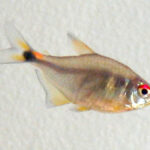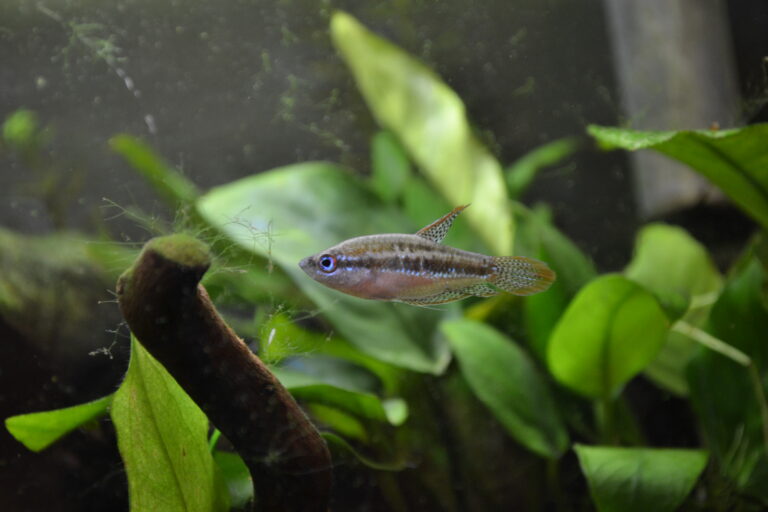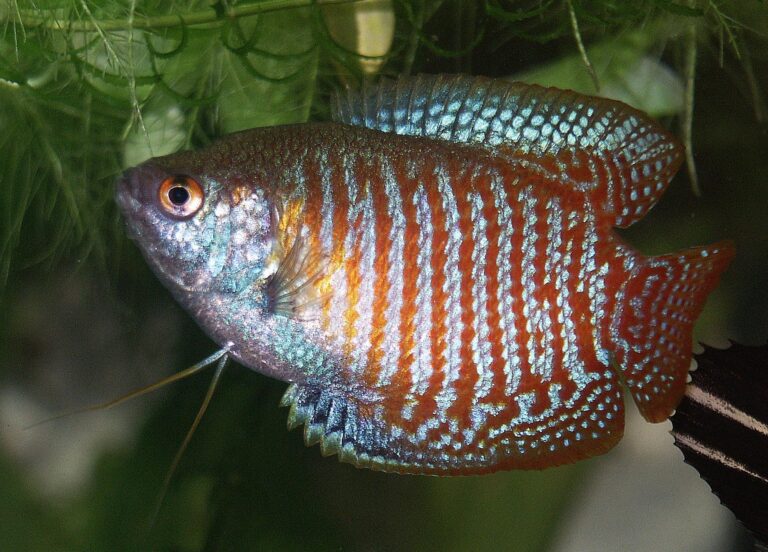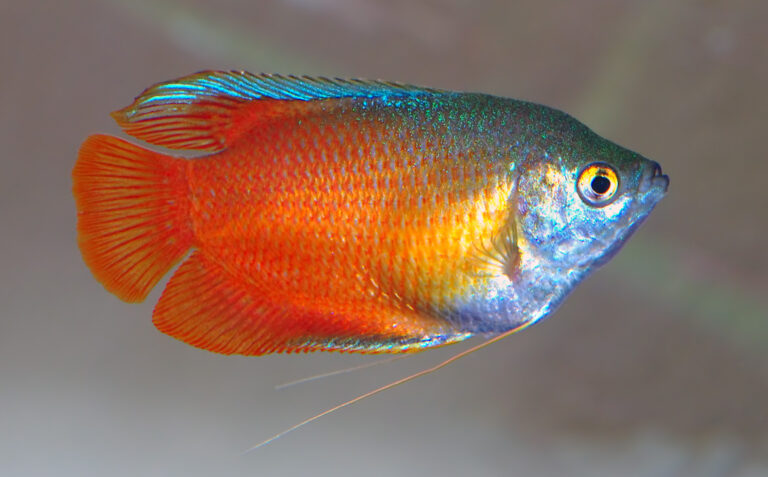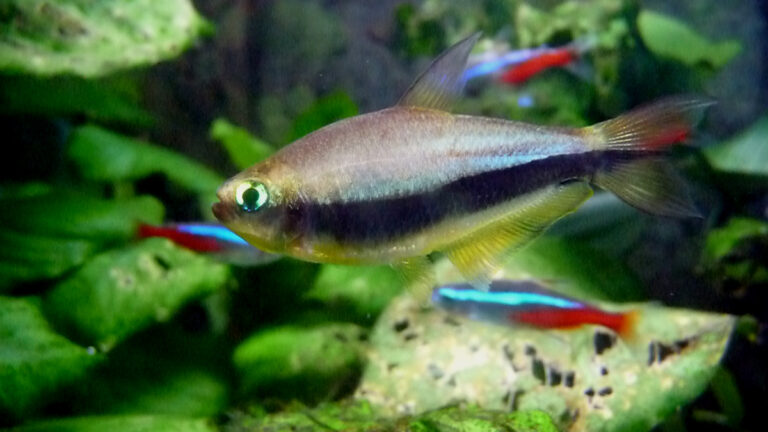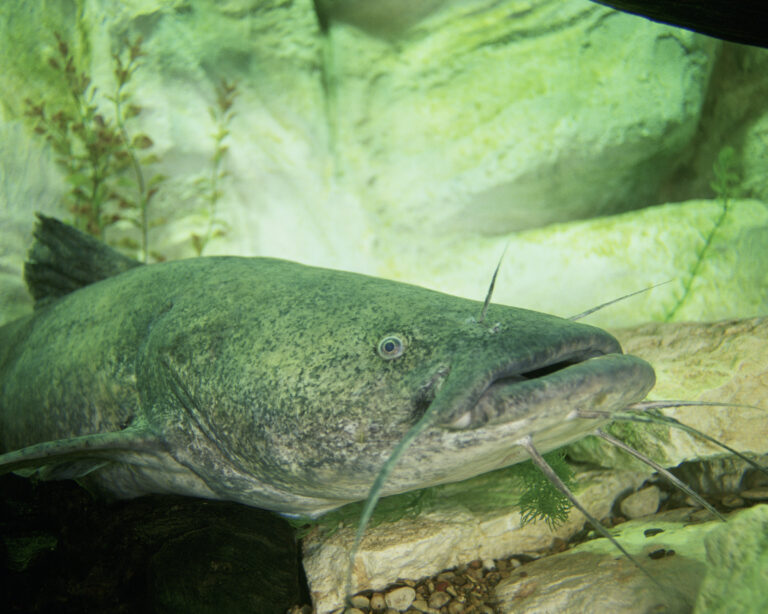Tiger Barb
By Ryan Maron | Last Modified: June 5, 2025
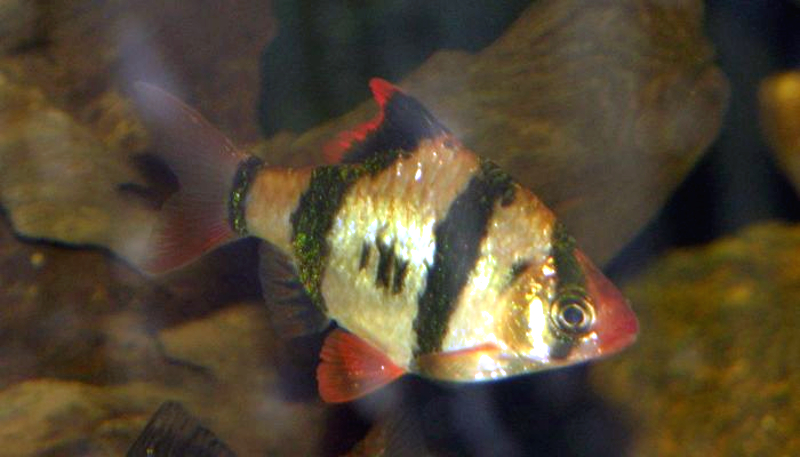
The Tiger Barb (Puntigrus tetrazona) stands as one of Southeast Asia’s most recognizable freshwater cyprinids, distinguished by its vibrant golden-orange coloration and distinctive black vertical stripes. This small yet dynamic schooling fish has garnered significant attention from both aquarists and ichthyologists due to its complex social behaviors and ecological adaptability. Native to the river systems of Indonesia, Malaysia, Thailand, and Cambodia, the Tiger Barb plays a crucial role as both predator and prey within its freshwater ecosystem, maintaining population balance among smaller invertebrates while serving as a vital food source for larger piscivorous species.
The species demonstrates remarkable ecological importance through its omnivorous feeding habits, contributing to nutrient cycling and algae control in tropical river environments. Tiger Barbs exhibit sophisticated schooling behaviors that influence community dynamics throughout their native range, making them essential components of Southeast Asian freshwater biodiversity. Their role as intermediate consumers places them at a critical juncture in aquatic food webs, where they help regulate populations of aquatic insects, small crustaceans, and plant matter while supporting larger predatory fish populations.
| Feature | Details |
| Common Name | Tiger Barb |
| Scientific Name | Puntigrus tetrazona |
| Family | Cyprinidae |
| Typical Size | 5-7 cm (2-2.8 inches), 15-25 grams |
| Habitat | Tropical freshwater rivers and streams |
| Diet | Omnivorous – insects, algae, small invertebrates |
| Distribution | Southeast Asia (Indonesia, Malaysia, Thailand, Cambodia) |
| Conservation Status | Least Concern |
Taxonomy & Classification
The Tiger Barb belongs to the family Cyprinidae, one of the largest freshwater fish families encompassing over 3,000 species worldwide. Originally described as Barbus tetrazona by Pieter Bleeker in 1855, the species underwent significant taxonomic revision in 2013 when molecular phylogenetic analysis revealed distinct evolutionary lineages within the traditional Barbus genus. This research led to the establishment of the genus Puntigrus, which now houses several Southeast Asian barb species previously classified under Barbus.
The genus Puntigrus represents a monophyletic group characterized by specific morphological and genetic markers that distinguish these fish from their African and European Barbus relatives. Within this genus, P. tetrazona shares close evolutionary relationships with P. partipentazona (the Partbelt Barb) and P. navjotsodhii, forming a species complex that diverged approximately 15-20 million years ago during the Miocene epoch.
Subspecific variation exists within Tiger Barb populations, with distinct morphological differences observed between Indonesian and mainland Southeast Asian populations. These variations primarily involve coloration intensity, fin morphology, and slight differences in body proportions, though all populations remain classified under the single species designation P. tetrazona. The taxonomic stability of this classification has been reinforced by recent genetic studies confirming species boundaries and population structure across the Tiger Barb’s natural range.
Physical Description
Tiger Barbs exhibit a laterally compressed, rhomboid body shape typical of active schooling cyprinids, with adult specimens reaching maximum lengths of 7 centimeters and weights of 25 grams. The species displays sexual dimorphism, with males developing more intense coloration and slightly smaller adult sizes compared to females. The characteristic golden-orange base coloration provides the backdrop for four prominent black vertical bands that extend from the dorsal region to the ventral surface, creating the distinctive striped pattern that inspired the common name.
The first black band passes through the eye, partially obscuring the pupil and creating a natural camouflage effect. The second band originates at the anterior edge of the dorsal fin, while the third band runs through the posterior section of the dorsal fin and anal fin origins. The fourth and most posterior band encircles the caudal peduncle just anterior to the tail fin. These bands may fade or intensify based on stress levels, social interactions, and environmental conditions.
Fin coloration varies between sexes, with mature males displaying vibrant red-orange edges on the dorsal, anal, and pelvic fins. Females typically show more subdued fin coloration with yellowish or clear margins. The dorsal fin contains 8-9 soft rays, while the anal fin possesses 8 rays. Scales are cycloid and relatively large, numbering 28-32 along the lateral line. The mouth is terminal and slightly downturned, equipped with pharyngeal teeth adapted for processing both plant and animal matter. During breeding periods, males develop pronounced tubercles on the snout and gill covers, serving as secondary sexual characteristics.
Habitat & Distribution
Tiger Barbs inhabit the tropical freshwater river systems of Southeast Asia, with their natural range encompassing the Mekong River basin, Malaysian Peninsula watersheds, and Indonesian archipelago waterways. These fish demonstrate preference for moderately flowing waters with temperatures ranging from 22-28°C and pH levels between 6.0-7.5. Native populations concentrate in tributary streams and smaller rivers where vegetation provides cover and feeding opportunities.
The species occupies various microhabitats within river ecosystems, including shallow riffle areas with rocky substrates, vegetated backwaters, and deeper pools with moderate current flow. Tiger Barbs show particular affinity for areas where overhanging terrestrial vegetation creates shaded zones and contributes to the aquatic food web through leaf litter and falling insects. Water hardness in natural habitats typically ranges from 5-15 dGH, reflecting the geological characteristics of Southeast Asian watersheds.
Seasonal variations significantly impact Tiger Barb distribution patterns, with populations migrating to deeper waters during dry seasons and expanding into flooded marginal areas during monsoon periods. These movements coincide with breeding cycles and food availability fluctuations. Human activities have altered many natural habitats through dam construction, agricultural runoff, and urban development, leading to localized population fragmentation and habitat degradation in some regions.
The species has established introduced populations in several countries outside its native range, including parts of Australia, Colombia, and Singapore, where escaped aquarium specimens have colonized suitable freshwater environments. These introductions raise ecological concerns regarding potential impacts on native tetra species and other small freshwater fish communities.
Diet & Feeding Behavior
Tiger Barbs exhibit omnivorous feeding behavior with opportunistic foraging strategies that adapt to seasonal food availability and habitat conditions. Their diet encompasses aquatic insects, small crustaceans, algae, plant matter, and detritus, positioning them as important intermediate consumers in freshwater food webs. Feeding activity peaks during dawn and dusk periods, though the species maintains opportunistic feeding throughout daylight hours.
Invertebrate prey constitutes approximately 60-70% of the natural diet, including chironomid larvae, small crustaceans, aquatic worms, and various arthropod species. The remaining dietary components consist of algae, diatoms, plant seeds, and organic detritus. Seasonal variations influence food preferences, with increased invertebrate consumption during wet seasons when prey abundance peaks, and greater reliance on plant matter during dry periods.
The species demonstrates cooperative feeding behaviors within schools, with individuals working collectively to disturb substrate materials and expose hidden prey items. This coordinated foraging strategy increases feeding efficiency and allows access to food resources unavailable to solitary feeders. Tiger Barbs possess well-developed pharyngeal teeth capable of processing various food textures, from soft plant materials to hard-shelled invertebrates.
Juvenile Tiger Barbs focus primarily on smaller prey items including zooplankton, small insect larvae, and algae, gradually incorporating larger prey as they mature. Adult feeding territories may overlap significantly within schools, with dominance hierarchies influencing access to preferred feeding locations. The species plays a crucial role in controlling aquatic insect populations and facilitating nutrient cycling through their feeding activities.
Behavior & Adaptations
Tiger Barbs exhibit complex schooling behaviors that serve multiple ecological functions including predator avoidance, foraging efficiency, and social organization. Schools typically consist of 20-100 individuals, though larger aggregations exceeding 500 fish have been documented during seasonal migrations. The species demonstrates sophisticated coordination mechanisms including synchronized swimming patterns, collective decision-making for feeding locations, and rapid response systems to predator threats.
Within school structures, Tiger Barbs establish dynamic dominance hierarchies based on size, age, and individual aggression levels. Dominant individuals occupy preferred positions within the school formation and gain priority access to food resources and potential mates. These social structures remain fluid, with rankings shifting based on environmental conditions and individual fitness changes.
The species has evolved several morphological and behavioral adaptations for their riverine lifestyle. Their streamlined body shape and powerful caudal fin provide efficient swimming capabilities necessary for maintaining position in flowing waters. The distinctive black banding pattern serves as disruptive coloration, making individual fish difficult to distinguish within schools and confusing potential predators.
Tiger Barbs display remarkable environmental adaptability, tolerating water temperature fluctuations, seasonal flow variations, and moderate pollution levels. This resilience has contributed to their success as both wild populations and aquarium species. The fish demonstrate learning capabilities and memory retention, with individuals recognizing familiar feeding locations and predator threats. Stress responses include color changes, altered swimming patterns, and modified schooling behavior, serving as important indicators of environmental conditions.
Reproduction & Life Cycle
Tiger Barb reproduction follows seasonal patterns closely linked to monsoon cycles and water temperature fluctuations across their native range. Breeding season typically occurs during the wet season months from May through September, when increased water levels and abundant food resources create optimal conditions for successful reproduction. Sexual maturity is reached at approximately 6-8 months of age and 4-5 centimeters in length.
Courtship behaviors involve elaborate displays by males, including intensified coloration, fin spreading, and territorial establishment within shallow spawning areas. Males develop breeding tubercles on their heads and gill covers, while females become noticeably fuller with developing eggs. Spawning occurs in pairs or small groups, with females releasing 200-500 eggs over vegetation or rocky substrates in shallow, well-oxygenated waters.
The adhesive eggs attach to aquatic plants, submerged branches, or rocky surfaces, where they remain vulnerable to predation and environmental fluctuations. Incubation periods range from 24-36 hours depending on water temperature, with optimal development occurring at 26-28°C. No parental care is provided after spawning, with adults often consuming their own eggs if encountered.
Newly hatched larvae possess yolk sacs that sustain them for the first 3-4 days of life. Once free-swimming, juvenile Tiger Barbs feed initially on zooplankton and gradually transition to the adult omnivorous diet. Growth rates vary significantly based on food availability, water temperature, and population density, with juveniles reaching adult size within 8-12 months under favorable conditions. The species typically lives 5-7 years in natural environments, though aquarium specimens may reach 8-10 years with proper care.
Predators & Threats
Tiger Barbs face predation pressure from various piscivorous species throughout their life cycle, with vulnerability levels changing significantly between juvenile and adult stages. Primary predators include larger cyprinids, catfish species, snakeheads, and various cichlid species that share Tiger Barb habitats. Aquatic birds such as kingfishers and herons pose additional threats, particularly in shallow feeding areas where schools become exposed.
Juvenile Tiger Barbs experience the highest predation rates, with mortality often exceeding 80% during the first month of life. Smaller predators including dragonfly larvae, water beetles, and other aquatic insects target newly hatched and small juvenile fish. Adult Tiger Barbs benefit from schooling behaviors that provide collective vigilance and predator confusion effects, significantly reducing individual predation risk.
Anthropogenic threats represent increasingly significant challenges for wild Tiger Barb populations across their native range. Habitat degradation through deforestation, agricultural expansion, and urban development has fragmented many river systems and reduced suitable spawning areas. Water pollution from industrial discharge, agricultural runoff, and domestic waste affects water quality and reduces prey availability.
Dam construction and water diversion projects alter natural flow patterns essential for Tiger Barb reproduction and migration behaviors. Climate change impacts include altered precipitation patterns, increased temperatures, and extreme weather events that disrupt seasonal breeding cycles. Overcollection for the aquarium trade has depleted some local populations, though most commercial Tiger Barbs now originate from captive breeding operations rather than wild harvest.
Invasive species introductions create additional competitive pressures and potential disease transmission risks in some regions. Habitat restoration efforts and improved water quality management represent critical conservation priorities for maintaining healthy Tiger Barb populations throughout their native range.
Conservation Status
The International Union for Conservation of Nature (IUCN) currently classifies the Tiger Barb as Least Concern, reflecting the species’ relatively stable population status and broad distribution across Southeast Asia. However, this classification masks significant regional variations in population health and local conservation challenges that warrant continued monitoring and management attention.
Population assessments indicate healthy Tiger Barb numbers throughout most of their native range, with particular abundance in protected watershed areas and regions with minimal human impact. The species demonstrates considerable resilience to environmental disturbances and maintains viable populations even in moderately altered habitats. This adaptability has prevented range-wide population declines despite increasing anthropogenic pressures.
Regional conservation concerns exist in heavily industrialized areas where water pollution and habitat modification have reduced local Tiger Barb populations. The Mekong River basin faces particular challenges from dam construction, agricultural intensification, and urban development that may impact long-term population sustainability. Conservation organizations recommend continued habitat protection and water quality monitoring in critical breeding areas.
The commercial aquarium trade has shifted largely to captive-bred specimens, reducing pressure on wild populations while maintaining economic value for local communities. Sustainable collection practices and habitat conservation programs provide additional protection for native populations. Research initiatives focus on population genetics, habitat requirements, and climate change impacts to inform future conservation strategies.
International cooperation between range countries supports habitat protection efforts and coordinates monitoring programs across political boundaries. These collaborative approaches recognize that Tiger Barb conservation requires ecosystem-level management that addresses watershed integrity and regional water resource management.
Human Interaction
Tiger Barbs maintain significant cultural and economic importance throughout Southeast Asia, where they serve traditional roles in subsistence fishing and local food systems. Rural communities have harvested these fish for generations using traditional methods including woven traps, seine nets, and small-scale angling techniques. While not a primary food source, Tiger Barbs contribute to local protein supplies and provide seasonal income opportunities for fishing families.
The global aquarium trade represents the most economically significant human interaction with Tiger Barbs, generating millions of dollars annually through commercial breeding operations and international exports. Singapore, Malaysia, and Thailand serve as major breeding and distribution centers, with millions of Tiger Barbs shipped worldwide each year. This industry supports thousands of jobs while reducing pressure on wild populations through captive breeding programs.
Educational and research applications utilize Tiger Barbs as model organisms for studying freshwater fish biology, behavior, and ecology. Their relatively simple husbandry requirements and observable social behaviors make them valuable for academic research and public aquarium displays. These applications contribute to broader understanding of freshwater ecosystem dynamics and fish community interactions.
Recreational fishing activities targeting Tiger Barbs occur primarily within their native range, where small-scale angling provides recreational opportunities for local populations. Basic freshwater fishing techniques effectively target these species using light tackle and appropriate bait selections.
Environmental management programs increasingly recognize Tiger Barbs as indicator species for freshwater ecosystem health, with population monitoring providing insights into broader environmental conditions. Their sensitivity to water quality changes makes them valuable for assessing the effectiveness of conservation interventions and habitat restoration efforts.
Interesting Facts
Tiger Barbs possess remarkable color-changing abilities that extend beyond simple stress responses, with individuals capable of rapid pigment adjustments for communication, camouflage, and thermoregulation. Research has documented over twelve distinct color pattern variations that convey different behavioral messages within schools, representing a sophisticated visual communication system among these seemingly simple fish.
The species demonstrates unexpected cognitive capabilities, including individual recognition within schools, spatial memory for feeding locations, and learned responses to environmental cues. Laboratory studies have confirmed that Tiger Barbs can distinguish between familiar and unfamiliar individuals, maintain memories of positive and negative experiences for several weeks, and exhibit problem-solving behaviors when seeking food or shelter.
Unique among many freshwater species, Tiger Barbs exhibit partial magnetoreception abilities that assist with navigation during seasonal migrations. This biological compass system helps schools maintain directional orientation during long-distance movements between feeding and spawning areas, contributing to their successful colonization of diverse river systems.
Tiger Barbs have been documented living in water temperatures as low as 18°C and as high as 32°C, representing exceptional thermal tolerance for tropical freshwater fish. This adaptability has enabled survival in altered habitats and contributed to their success as introduced species in non-native environments.
The species plays an unexpected role in traditional medicine systems across Southeast Asia, where various Tiger Barb preparations are believed to treat respiratory ailments and digestive disorders. While scientific evidence for these applications remains limited, this cultural use demonstrates the deep historical connections between local communities and these fish.
Recent genetic studies have revealed that Tiger Barbs possess unusually high genetic diversity compared to other cyprinid species, suggesting ancient population expansions and complex evolutionary history. This genetic richness may contribute to their environmental adaptability and resilience to habitat changes, providing evolutionary advantages for long-term species survival.
Frequently Asked Questions
Are Tiger Barbs suitable for beginner aquarists?
Tiger Barbs can be appropriate for novice aquarists who understand their social requirements and provide adequate tank space. These fish require groups of at least six individuals to prevent aggressive behavior and need well-maintained water conditions with temperatures between 22-26°C. Their active nature and schooling behavior make them engaging pets, though their semi-aggressive temperament requires careful tank mate selection.
How do Tiger Barbs compare to other popular aquarium fish?
Unlike peaceful community fish such as various tetra species, Tiger Barbs display more assertive behaviors and require specific social conditions to thrive. They are more active and territorial than many cyprinids but less aggressive than cichlids, occupying a middle ground in community aquarium compatibility. Their care requirements are less demanding than specialized species but more complex than truly beginner-friendly fish.
What size aquarium do Tiger Barbs require?
A minimum 75-liter (20-gallon) aquarium is necessary for a small school of Tiger Barbs, though larger tanks of 150 liters (40 gallons) or more provide better swimming space and water stability. The tank should be longer rather than taller to accommodate their active swimming behavior and schooling patterns. Adequate filtration and regular water changes are essential for maintaining water quality with these messy feeders.
Can Tiger Barbs be caught using recreational fishing methods?
Tiger Barbs can be caught using light tackle and small hooks with appropriate bait, though they are not typically targeted by recreational anglers outside their native range. Effective river fishing techniques include using small flies, tiny spinners, or natural baits such as bloodworms and small insects. Their schooling behavior means successful catches often yield multiple fish in quick succession.
Conclusion
The Tiger Barb represents a remarkable example of freshwater fish adaptability and ecological importance within Southeast Asian river systems. Their role as intermediate consumers, sophisticated social behaviors, and resilience to environmental changes make them valuable both as wild species and aquarium subjects. While currently stable across most of their range, continued habitat protection and sustainable management practices remain essential for ensuring long-term Tiger Barb population health and the integrity of the freshwater ecosystems they help sustain.
Share The Article:
More Fish Species:
-
Endlers Livebearer
The Endlers Livebearer (Poecilia wingei) stands as one of the most captivating freshwater fish species in the aquarium trade…
-
Yellow Bullhead
The Yellow Bullhead (*Ameiurus natalis*) represents one of North America’s most widespread and ecologically significant freshwater catfish species. This…
-
Sparkling Gourami
The Sparkling Gourami represents one of the most captivating miniature freshwater species available to aquarium enthusiasts and serves as…
-
Dwarf Gourami
The Dwarf Gourami (Trichogaster lalius) stands as one of the most popular freshwater aquarium fish species, renowned for its…
-
Oceanic Whitetip Shark
The Oceanic Whitetip Shark (*Carcharhinus longimanus*) stands as one of the ocean’s most formidable and recognizable apex predators, distinguished…
-
Honey Gourami
The Honey Gourami (*Trichogaster chuna*) stands as one of the most captivating freshwater fish species in the aquarium trade,…
Discover
-
Spinner Shark
The Spinner Shark (Carcharhinus brevipinna) stands as one of the ocean’s most distinctive and acrobatic predators, earning its name…
-
How to Catch Mahi-Mahi: Offshore Tactics That Fill Coolers Fast
I still remember my first encounter with mahi-mahi (also called dolphin fish or dorado). We were about 20 miles…
-
Dusky Shark
The Dusky Shark represents one of the most ecologically significant yet vulnerable large predators inhabiting coastal and pelagic waters…
-
Why Your Red Drum Strategy Is All Wrong (Fix It Today)
Last October, I was fishing the eastern shore of Lake Michigan near Ludington with my buddy Mike. Cold front…
-
Porbeagle Shark
The Porbeagle Shark (*Lamna nasus*) stands as one of the most fascinating and ecologically significant predators in the North…
-
Best Time to Go Fishing: Timing Tips for Bigger Catches
If there’s one question I get asked more than any other, it’s about timing. When should you cast that…
Discover
-
Bass Fishing Techniques: Expert Tips That Actually Work
Bass fishing has been my passion for over three decades, and if there’s one thing I’ve learned, it’s that…
-
Silver Dollar Fish
The Silver Dollar Fish (*Metynnis argenteus*) stands as one of South America’s most recognizable freshwater species, renowned for its…
-
Emperor Tetra
The Emperor Tetra (*Nematobrycon palmeri*) stands as one of the most distinctive and sought-after freshwater fish species in the…
-
Flathead Catfish
The Flathead Catfish stands as one of North America’s most formidable freshwater predators, commanding respect from both anglers and…
-
Mastering Fishing Casting Techniques: Complete Guide
Have you ever watched someone cast their line with perfect precision while you struggle to avoid tangling yours in…
-
Midas Cichlid
The Midas Cichlid (Amphilophus citrinellus) stands as one of Central America’s most recognizable and ecologically significant freshwater fish species….





